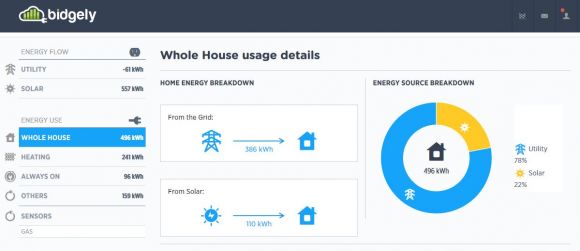Distributed solar power is having a big impact on Hawaii’s grid, leading state utilities and regulators to look to a variety of technologies to help it manage this new edge-of-the-grid resource. That includes smart meters and smart solar inverters, networked electric vehicle chargers, fast-responding demand response, and both distributed and utility-scale energy storage -- and now, energy disaggregation from Sunnyvale, Calif.-based startup Bidgely.
On Wednesday, the Khosla Ventures-backed software startup announced it has received a $900,000 grant from the Hawaii Energy Excelerator to bootstrap a pilot project with at least two Hawaiian utilities. Starting in the next few months, Bidgely plans to reach up to 10,000 homes with its software, which can tease out individual household energy loads like air conditioning, water heating, pool pumps and appliances from smart meter or other whole-home energy data, CEO Abhay Gupta told me in an interview this week.
Bidgely will be providing customers with web and mobile access to energy usage data broken out into these categories, along with comparisons to neighbors and to past usage, as well as suggestions for energy savings, Gupta said. It’s also going to be delivering the information to its partner utilities with the same disaggregated view, which will offer “insight into homes that they’ve never had before,” he said.
Energy disaggregation, also known as non-intrusive load monitoring, is a promising technology just now coming into play for utilities, with smart meters, home sensors and other new sources of interval energy usage data providing the raw materials for various advanced analytics. Startups like Bidgely, PlotWatt, Navetas and Energy Aware, original technology developers like Enetics, and big companies including Belkin and Intel are all trying out different versions of disaggregation technology.
Bidgely has partnered with thirteen utilities in the United States and Europe, including big utilities like California’s Pacific Gas & Electric, as well as retail energy providers in deregulated energy markets, Gupta said. In Hawaii, “We believe we can make a major impact, for a few reasons,” he added.
“One, energy efficiency is important in Hawaii, because electricity rates are so high.” Hawaii’s electric rates are among the highest in the nation, at 40 cents or more per kilowatt-hour -- a fact that has helped make rooftop solar attractive to homeowners, as well as offering a faster payback for the average efficiency gains of 6 percent to 10 percent that Bidgely has been able to show in other utility projects.
“Two, there’s a very heavy penetration of solar,” he said -- and “for solar homes, we can do energy efficiency and give people a sense of how to manage and optimize their use,” he said. Earlier this summer, Bidgely announced it’s working on solar disaggregation algorithms to measure rooftop PV’s influence on household energy costs and usage patterns over time -- and, potentially, to advise users how to alter their energy behavior to help balance that solar power’s impact on their neighborhood grid.

Third, “because of the heavy penetration of solar, there are these grid stability problems” that the state’s utilities are grappling with. Late last year, Oahu utility Hawaiian Electric announced a halt to new distributed solar grid interconnections, to give it time to figure out how to safely and reliably incorporate more distributed solar into grid operations -- a move that’s thrown the state’s formerly fast-growing solar industry into a nosedive.
Dora Nakafuji, director of renewable energy planning for Hawaiian Electric, told me last week that the utility was working with the Energy Excelerator on deploying technology that “gives customers more visibility into their load, in terms of providing more granularity for their usage profiles.”
The utility already collects lots of data from solar inverters, grid sensors, weather stations and other sources to inform its understanding of how solar is affecting its day-to-day grid operations, Nakafuji noted. But fifteen-minute interval data that combines solar inputs and demand on a house-by-house basis is ”what we’ve been lacking. […] Through this and other Energy Excelerator projects, we should [be able]...to gather that data.”

At last week’s Soft Grid 2014 conference, panelists discussing the latest in solar and energy storage analytics noted that demand-side data is also important to delivering a complete picture of the effects of distributed energy on the edges of the grid. Customer-owned solar is often unmonitored by utilities, but solar-rich regions like California, Germany and Hawaii are looking toward smart meters, smart inverters, weather forecasting and big-data aggregation and analysis to help incorporate them into day-to-day grid operations.
Bidgely and its Hawaiian utility partners are still working out the details on how the startup’s home-by-home disaggregation data could inform the utility’s distribution grid operations and planning needs, Gupta said. But possibilities could include better load forecasting, as well as measurement and verification (M&V) for programs that target specific customers for incentives or programs aimed at easing solar’s impact on the local grid, he added.
One thing’s for sure -- Hawaii is a canary in the coal mine for the potential for ever-cheaper solar PV, along with distributed energy storage, to present an existential threat to today’s utility business models. Energy could help customers and utilities alike learn a lot more about how they can share the benefits of this distributed energy revolution.
“When a utility says to a customer, ‘I want you to buy solar from me,’ or ‘I want you to move to this rate plan,’ or ‘I want you to use energy at this time, not that time,’ those are all possibilities because of customer engagement with their energy use,” he said. “First there is information, then there is motivation, then there is empowerment. I think that utilities are recognizing the value of energy empowerment.”



